|
  Download
Reader's Guide as a PDF Download
Reader's Guide as a PDF
from Unbridled Books.

About
the Book
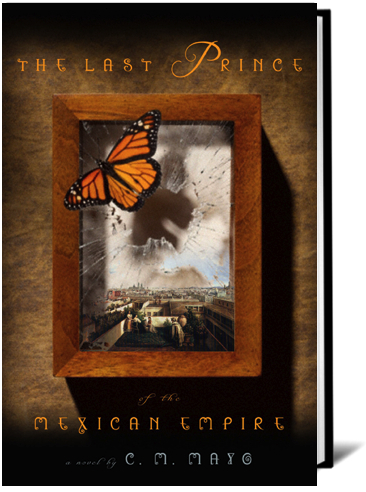 The Last Prince of the Mexican Empire is a meticulously researched, strongly
felt, and vividly rendered novel from history. It tells a story
that in its time was infamous, an international scandal, but
ended up lost, reduced to a footnote —literally, in one
accounting— to history. The Last Prince of the Mexican Empire is a meticulously researched, strongly
felt, and vividly rendered novel from history. It tells a story
that in its time was infamous, an international scandal, but
ended up lost, reduced to a footnote —literally, in one
accounting— to history.
As the author explains in the Epilogue to the novel, "The
Story of the Story," it grew from a "germ" so
perfectly Jamesian that she couldn’t have made it up if
she tried.
Having lived in Mexico City for several years and considering
herself to be relatively well educated and informed, fluent in
Spanish, Mayo came across a painting on the wall over lunch at
someone’s home, a portrait of a little English looking boy,
cradling a rifle, with Chapultepec
Castle in the background. When she asked, she was told that
the subject is Augustin
de Iturbide y Green, "the prince of Mexico." Astonished
by her ignorance of that period in Mexican history and understandably
intrigued by the notion of monarchy in the New World, she tried
for several months to find out more, to no avail, until she was
halfway through reading Jasper Ridley’s Maximilian and
J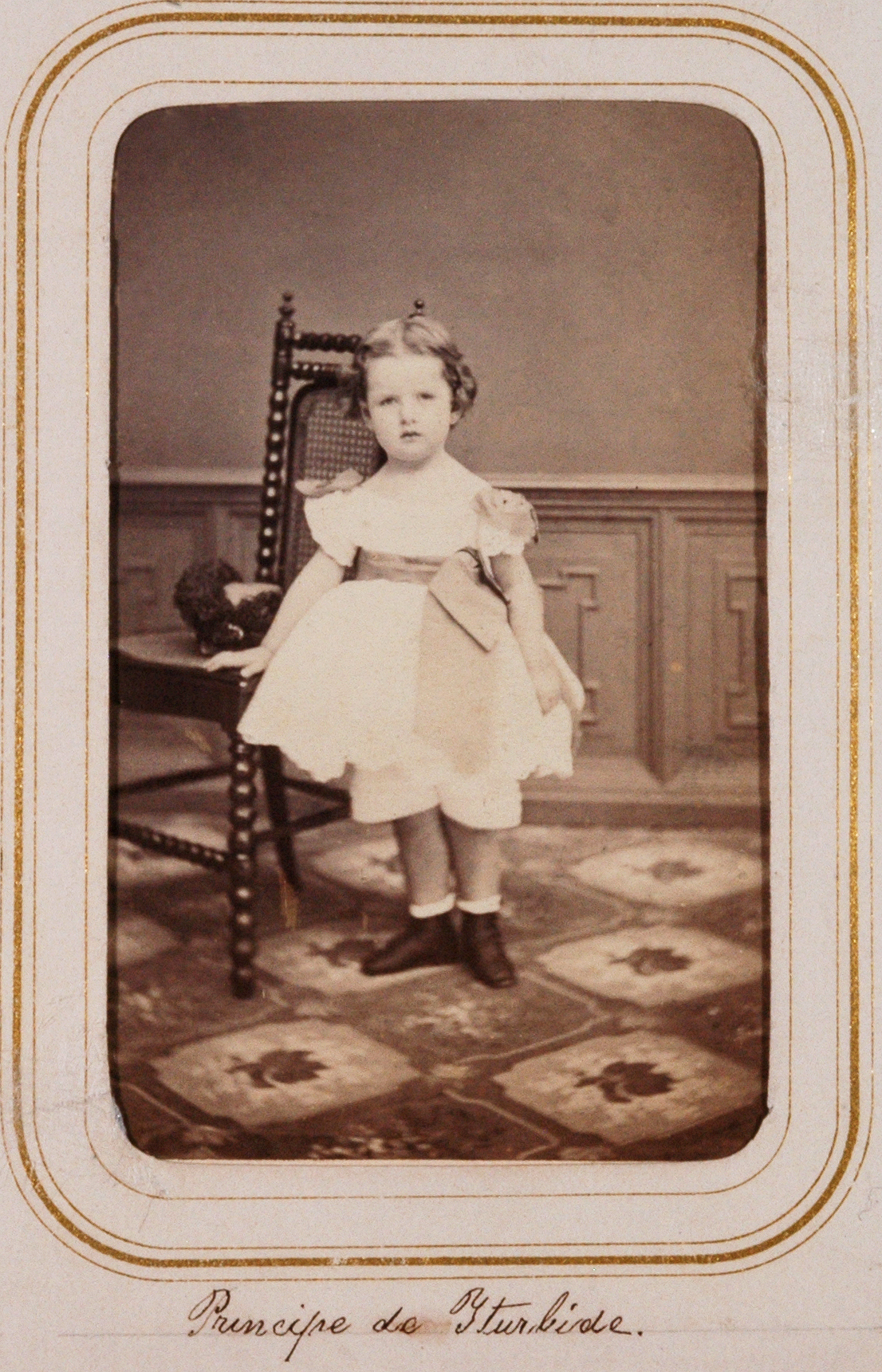 uarez
and came upon the chapter, "Alice Iturbide": uarez
and came upon the chapter, "Alice Iturbide":
My surprise at finding my
own countrywoman, long ago, at the apex of the Mexican aristocrac— both antagonist and victim,
motivated and blinded by who knew what medley of ambition, avarice,
love, borrowed patriotism or naiveté—so intrigued
me I knew at once I wanted to explore and expand the story into
a novel.
The core story is that during
the short lived Second Empire in Mexico, Emperor
Maximilian and Empress Carlota take custody of the toddler
son of a Mexican aristocrat and an American mother, grandchild
of the first Emperor of Mexico, to be their heir presumptive.
But in the way that novels have of doing, it took 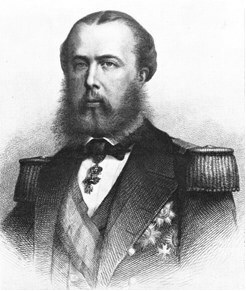 on
a life of its own, and the story of two heartbroken parents trying
to get their little boy back from a callous pair of Royals growing
more unstable by the day as the French withdraw from Mexico and
their Second Empire comes crashing down around them, grew into
something much larger: an international story of political intrigue,
war and diplomacy that plays out in Mexico City, Washington,
D.C., England, Paris, and even Rome, that overlaps the U.S.
Civil War and tells of the complex border politics between Mexico
and the U.S., especially with the Confederacy, both before and
afterwards. on
a life of its own, and the story of two heartbroken parents trying
to get their little boy back from a callous pair of Royals growing
more unstable by the day as the French withdraw from Mexico and
their Second Empire comes crashing down around them, grew into
something much larger: an international story of political intrigue,
war and diplomacy that plays out in Mexico City, Washington,
D.C., England, Paris, and even Rome, that overlaps the U.S.
Civil War and tells of the complex border politics between Mexico
and the U.S., especially with the Confederacy, both before and
afterwards.
Most of all, The Last Prince
of the Mexican Empire is a novel about the very question
of what it would mean to be Mexican. Would the people of Mexico
be subjects, or citizens? Just as important, however, we learn
along the way how we historically, politically, and culturally
share so much more with our neighbor to the South than we commonly
think we do.
Lucky for us, Mayo decided that
the only way she could get at this question was to tell "an
emotional truth," and only the novelist has the tools to
do that, to explore the emotions and motivations of the characters
involved in the events of the narrative: the creative imagination
and what Mayo calls the use of "armchair sociology."
One such use is a fortunate consequence of her decision to tell
the story from multiple
points of view, including the multiple points of view among
the characters about
each other. They reveal themselves through their interactions
and gossip about the other characters, drawn from the letters,
journals, diaries, and other materials Mayo spent years combing
through and, best of all, we come to realize that some questions
are ultimately unanswerable— the essence of good writing.
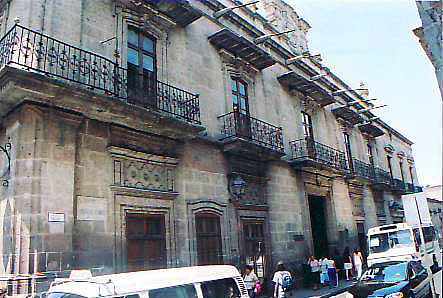
Further, by recreating on the page the sights, smells and sounds
of Mexico City, Cuernavaca, Georgetown, Paris, and the novel’s
other settings, both outside and inside, Mayo is not just painting
a backdrop against which the characters play out the drama. Rather,
she creates a "virtual reality" for the reader to stroll
about in, to see things as the characters perceive and experience
them, including what they wear, where and why they wear it, how
they behave, and what they talk about, all of which serve to
carry the narrative.
Our noses tingle from the dust
in Doña Juliana’s parlor that coats the knick knacks
on the shelves, each of which tells us something about her personal
and political history. We positively taste Alicia’s strawberry
pies, for which she is famous, which remind us of her personal
history and values, and reinforce the bicultural nature of her
marriage and relationship with her husband.
Finally, by enabling us to see her characters within their particular
worlds, both public and private, to hear what they are saying
and how they are behaving about and to one another, we empathize
with them, create our own versions of them, and draw our own
conclusions about them, to better understand the larger and essential
meanings of the narrative.
About
the Author
 C. M. Mayo was born in Texas in 1961
and grew up in California. Having written since she was a child,
Mayo wanted to start taking her writing seriously when she was
in her early 20’s, but didn’t know how to proceed.
She did study for a summer under Paul Bowles, in Morocco, but
after coming back found herself still baffled by "how to
go about being a writer," not to mention a little intimidated
by the "jumping off into the abyss" images of how she
would make a living as a writer. C. M. Mayo was born in Texas in 1961
and grew up in California. Having written since she was a child,
Mayo wanted to start taking her writing seriously when she was
in her early 20’s, but didn’t know how to proceed.
She did study for a summer under Paul Bowles, in Morocco, but
after coming back found herself still baffled by "how to
go about being a writer," not to mention a little intimidated
by the "jumping off into the abyss" images of how she
would make a living as a writer.
So she took the more practical path, earning her Master’s
Degree in economics from the University of Chicago in 1985, where
she met her husband, a prominent Mexican economist. After moving
with him to Mexico City, she taught international and development
finance in both the undergraduate and the MBA programs at ITAM,
a private university, and (as Catherine
Mansell Carstens) published two books on finance, before
turning to literary writing:
"I realize now that it's
tricky to start writing serious fiction until you are in your
30’s, anyway. I think that you have to settle down, and
have a sense of compassion for other people, which is what you
really need to flesh out fictional characters. Most people in
their 20’s are about "me" and to write fiction,
you have to come from a more spiritual place than that. And that
just takes a little time. So I went into economics, which has
its fascinating aspects, but for me, alas, not enough of them.
When I turned 30, I decided it was time to "fish or cut
bait": if I wanted to be a writer, I had to start taking
that seriously. I did some research, and found some good writers
conferences to go to, and just took it from there. One really
does have to educate oneself as a writer, and it’s not always
easy or obvious as to how to go about doing that; certainly it
helped that I was a little bit older."
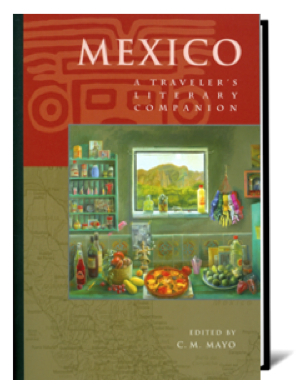 C.M. Mayo started by writing short fiction,
and her first book, Sky Over
El Nido, won the Flannery O'Connor Award for Short Fiction.
Her second book, Miraculous Air:
Journey Of A Thousand Miles through Baja California, the Other
Mexico, is a widely-lauded travel memoir. It was written
at a time when Mexico was going through a major political crisis.
She undertook it to try to come to understand Mexico better,
"when all I wanted to do was to leave." An avid translator
of contemporary Mexican literature, Mayo is founding editor of
Tameme Chapbooks ~ Cuadernos, and has also edited the anthology
Mexico: A Traveler's Literary Companion,
a portrait of Mexico in the fiction and literary prose of 24
Mexican writers. C.M. Mayo started by writing short fiction,
and her first book, Sky Over
El Nido, won the Flannery O'Connor Award for Short Fiction.
Her second book, Miraculous Air:
Journey Of A Thousand Miles through Baja California, the Other
Mexico, is a widely-lauded travel memoir. It was written
at a time when Mexico was going through a major political crisis.
She undertook it to try to come to understand Mexico better,
"when all I wanted to do was to leave." An avid translator
of contemporary Mexican literature, Mayo is founding editor of
Tameme Chapbooks ~ Cuadernos, and has also edited the anthology
Mexico: A Traveler's Literary Companion,
a portrait of Mexico in the fiction and literary prose of 24
Mexican writers.
Her other awards include three
Lowell Thomas Travel Journalism Awards and three Washington Writing
Awards, most recently for her essay about a visit to Maximilian's
Italian castle, "From
Mexico to Miramar or, Across the Lake of Oblivion,"
published in the Massachusetts Review (also available
online at cmmayo.com/publications). Mayo currently divides her
time between Mexico City and Washington, D.C.
Interview
with the Author
 You started writing with short fiction,
followed by your memoir of Baja California, Miraculous
Air. Did it serve as a transition into the novel, and
such a massive undertaking, at that? You started writing with short fiction,
followed by your memoir of Baja California, Miraculous
Air. Did it serve as a transition into the novel, and
such a massive undertaking, at that?
Definitely, especially with narrative
structure, a huge issue for me as a writer. Before the travel
memoir, I had written two books on finance, which helped me learn
how to structure a book length argument and, well, to just keep
plodding away at it! The travel memoir has a much more complex
structure, and then of course, the novel has an intriciate, even
labyrinthical structure. So with each book, I think I have progressed
in terms of mastering structure. At least I hope I have. And
of course Miraculous Air,
in recounting a series of journeys through "the Other Mexico"
that explores its independence from and connections to mainland
Mexico, is a kind of meditation on Mexico itself.
I wanted to ask you about
your decision to structure the novel by specific calendar days.
Was that an organic outcome of the creative process, or did those
dates correspond to historical events?
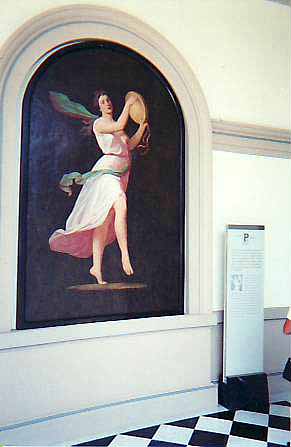 Yes,
in most cases they corresponded, but the structure of the novel
is that the opening three chapters, Book One, are set in a certain
time period but not on a particular day. The same can be said
of Book Three. Yes,
in most cases they corresponded, but the structure of the novel
is that the opening three chapters, Book One, are set in a certain
time period but not on a particular day. The same can be said
of Book Three.
But the bulk of the novel, the eighteen chapters that cromprise
Book Two, has a very different structure. Each chapter is set
on one specific date, beginning with "September 17, 1865:
The Prince Is in the Castle", when the secret contract between
Maximilian and the Iturbide family has begun, and ending with
"October 25, 1866: The Road to Orizaba", the date on
which Maximilian, in writing the letter releasing the child to
his parents, breaks the contract. In sum, Book Two is the life
of the contract, and though we have multiple flashbacks and flashforwards,
it has a linear, tick-tick-tick, structure.
But there is a second reason why each chapter corresponds to
one day: the novel not only has multiple points of view, it's
a transnational international story— we have the French
army, we have the Austrian aristocrats, we have Americans, we
have Mexicans, and Belgians, and Hungarians and Queen Victoria
and the Pope... it's complicated! And I realize, it would be
challenging beyond reason for the reader to follow who’s
who and what’s what without an anchor. That anchor is the
date.
And there is a third reason: to emphasize the long lags between
events and news of those events. In Mexico, for example, people
would learn about things that had happened in Europe weeks, even
months earlier. As the telegraph developed and the trans-Atlantic
Cable was laid in 1866, the the news speeded up. But compared
to our world, it was so very slow and affected—sometimes
tragically—some of the characters's decisions. This is a
recurring theme in the novel.
You have said that this novel
is about what it means, or meant to be, a Mexican. Could you
elaborate on that?
 The
Second Empire was the assertion by the French, the Catholic Church,
and a group of Mexican conservatives that Mexicans should be
subjects. On the other hand, the Juarista response— ultimately
victorious— was that, no, Mexicans are citizens. Citizens
of a Republic. There is a fundamental difference between being
a subject and being a citizen. The former requires obedience
while the latter calls for participation. I could go on. But
more than that: Maximilian, for instance, genuinely saw himself
as Mexican, whereas any modern Mexican would probably roll their
eyes and huff, "how ridiculous!" Maximilian was an
Austrian aristocrat, imposed by a foreign army. Yet let's not
forget, in fact there were many Mexicans who welcomed and supported
him. The
Second Empire was the assertion by the French, the Catholic Church,
and a group of Mexican conservatives that Mexicans should be
subjects. On the other hand, the Juarista response— ultimately
victorious— was that, no, Mexicans are citizens. Citizens
of a Republic. There is a fundamental difference between being
a subject and being a citizen. The former requires obedience
while the latter calls for participation. I could go on. But
more than that: Maximilian, for instance, genuinely saw himself
as Mexican, whereas any modern Mexican would probably roll their
eyes and huff, "how ridiculous!" Maximilian was an
Austrian aristocrat, imposed by a foreign army. Yet let's not
forget, in fact there were many Mexicans who welcomed and supported
him.
So, what it is to be a Mexican is in part a cultural question,
but it’s also a political question, as in, "Who says?"
So if you’re a person from Czechoslovakia living in Mexico,
are you Mexican? In part that’s a legal question, depending
on your documents, and it’s also a cultural question. Modern
Mexico is incredibly diverse. I know of people who are 4th generation
Mexicans who have English names and consider themselves ethnically
English. We also have many indigenous peoples, some of whom who
don't speak Spanish. There are Russian and Polish Jews, a large
Lebanese community, Italians, French, Irish, Cubans, Guatemalans.
In recent years an increasing number of U.S. citizens have moved
down to Mexico and become naturalized Mexican citizens. In sum,
Mexico is more complex and diverse than many Americans perceive.
You have said that this very
brief, three year period, going on at the same time as our Civil
War, was a crucial turning point in Mexican history. How so?
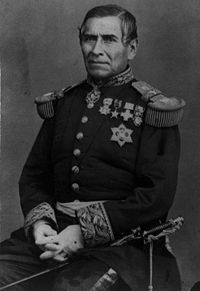 This
is the story of the defeat of an idea: the monarchy. Today Mexicans
are not subjects but citizens. Let's not forget, one hundred
fifty years ago, the monarchical form of government, while not
universally, was widely accepted. This period in history is also
significant because, though Mexico has had a long history of
foreign invasions, and this was the ugliest of all. It was massive
and brutal, and though strenuous efforts, it was defeated. This
is why Cinco de Mayo, the commeoration of the battle of Puebla
on May 5, 1862, is so important to Mexicans. It was not a definitive
defeat of the French— only a temporary one, it turned out,
for the French regrouped and took Puebla a year later. However,
it was powerfully symbolic. That the rag-tag Army of the Republic
of Mexico could humiliate the French Imperial Forces, then considered
the greatest in the world, was no small thing. It was David slingshotting
Goliath: an international sensation. This
is the story of the defeat of an idea: the monarchy. Today Mexicans
are not subjects but citizens. Let's not forget, one hundred
fifty years ago, the monarchical form of government, while not
universally, was widely accepted. This period in history is also
significant because, though Mexico has had a long history of
foreign invasions, and this was the ugliest of all. It was massive
and brutal, and though strenuous efforts, it was defeated. This
is why Cinco de Mayo, the commeoration of the battle of Puebla
on May 5, 1862, is so important to Mexicans. It was not a definitive
defeat of the French— only a temporary one, it turned out,
for the French regrouped and took Puebla a year later. However,
it was powerfully symbolic. That the rag-tag Army of the Republic
of Mexico could humiliate the French Imperial Forces, then considered
the greatest in the world, was no small thing. It was David slingshotting
Goliath: an international sensation.
What about the issue of church
and state? Was that part of the Republican movement?
 It
would be difficult to overstate the power of the Church in Mexico
at that time. Just in Mexico City, when you see how much real
estate they owned, nd how much money the Church had, it is really
jaw-dropping. And they also owned huge haciendas worked with
slaves. So that was a continuing is It
would be difficult to overstate the power of the Church in Mexico
at that time. Just in Mexico City, when you see how much real
estate they owned, nd how much money the Church had, it is really
jaw-dropping. And they also owned huge haciendas worked with
slaves. So that was a continuing is sue
throughout the 19th century in Mexico – how much power does
the church have, and how much the state? The Church supported
Maximilian and the French invasion in part because the Republicans
had confiscated Church property. It turned out, however, that
Maximilian did not reinstate the Church's properties. It just
wasn't feasible. But this remained a source of friction between
Maximilian and the Church. Another was that Maximilian was a
little too liberal for the Church; among other things the Church
objected to, he wanted to encourage immigration from ther ex-Confederacy
and from Europe, and he was willing to accept (gasp!) freedom
of worship for Protestants. In sum, though the Church supported
the Mexican Empire, it had its own interests and they did not
invariably align with Maximilian's. sue
throughout the 19th century in Mexico – how much power does
the church have, and how much the state? The Church supported
Maximilian and the French invasion in part because the Republicans
had confiscated Church property. It turned out, however, that
Maximilian did not reinstate the Church's properties. It just
wasn't feasible. But this remained a source of friction between
Maximilian and the Church. Another was that Maximilian was a
little too liberal for the Church; among other things the Church
objected to, he wanted to encourage immigration from ther ex-Confederacy
and from Europe, and he was willing to accept (gasp!) freedom
of worship for Protestants. In sum, though the Church supported
the Mexican Empire, it had its own interests and they did not
invariably align with Maximilian's.
Tell us about "falling
into the eggplant patch." This is a Mexican expression used
in the novel which might apply to your difficulties in researching
this novel.
 On
its face, this is a confusing story. Why did Maximilian take
the little boy away from his parents and exile them? And why
did the parents, at least initially, agree to this? To answer
these questions we have to first, understand the social and political
context at the time, and second, get beyond our common understanding
of the meaning of a family. Many historians talk about Maximilian's
"adopting" the little boy, but that is not quite the
right word. On
its face, this is a confusing story. Why did Maximilian take
the little boy away from his parents and exile them? And why
did the parents, at least initially, agree to this? To answer
these questions we have to first, understand the social and political
context at the time, and second, get beyond our common understanding
of the meaning of a family. Many historians talk about Maximilian's
"adopting" the little boy, but that is not quite the
right word.
Maximilian understood it as more or less analogous to the relationship
between Louis Napolean, the Emperor of France, and the Murat
Princes. And in this day and age, for heavensakes, who remembers
the Murat princes?! But if you don’t know who they were,
it’s very difficult to understand what Maximilian was thinking.
Basically what he was saying was, I grant the Iturbides the
status of Highnesses and as such they join my house. So he
did not think of the child as his own but rather as a kind of
cousin— a member of an extended family under his leadership
and protection. It’s that concept that’s very difficult
to understand with a 20th-21st century mentality. And to add
to the confusion, many people who were close to Maximilian at
the time were themselves quite flummoxed.
 The
second reason why it was difficult to tell the story is that
the period itself is incredibly complex. In fact we cannot consider
it "Mexican" history so much as it is transnational
history. Why did French invade Mexico? Why did the Church support
this? Why did the Kaiser of Austria allow his younger brother
go? Who was Maximilian's wife, the Empress Carlota? She was the
Princess of Belgium and the first cousin of Queen Victoria. And
both King Leopold of the Belgians and Queen Victoria had plenty
to say about Mexico. England had many important businesses in
mining and textiles and so on, so the British Ambassador was
an important figure in Mexico, and in any event, what Queen Victoria
thought of all this was vital to all concerned. And of course
the United States were scheming to get the French out of Mexico,
plus there was the business of the Confederacy and its relationship
to Mexico. So it was an extraordinarily complex period. The
second reason why it was difficult to tell the story is that
the period itself is incredibly complex. In fact we cannot consider
it "Mexican" history so much as it is transnational
history. Why did French invade Mexico? Why did the Church support
this? Why did the Kaiser of Austria allow his younger brother
go? Who was Maximilian's wife, the Empress Carlota? She was the
Princess of Belgium and the first cousin of Queen Victoria. And
both King Leopold of the Belgians and Queen Victoria had plenty
to say about Mexico. England had many important businesses in
mining and textiles and so on, so the British Ambassador was
an important figure in Mexico, and in any event, what Queen Victoria
thought of all this was vital to all concerned. And of course
the United States were scheming to get the French out of Mexico,
plus there was the business of the Confederacy and its relationship
to Mexico. So it was an extraordinarily complex period.
A third reason: for many Mexicans
the period is politically embarrassing. It’s easier to say,
well, these were foreign invaders, and we repelled them –
a truth that is not the whole big, messy, and oh-so human truth.
To take one of many examples, there is a museum in Mexico City
of the Mexican equivalent of the Secret Service. But are there
photos, uniforms, or arms of any of Maximilian's Palatine Guards
in there? Not on your life! So you see, there are many stories
that have been hidden or buried.
Finally: when I looked at the
main works on the Second Empire what I found about the little
prince, Maximilian's the arrangement with the Iturbides, was
really peculiar. In the memoirs of those who had been close to
Maximilian or in Mexico City society at the time, the affair
was barely mentioned, or garbled in the strangest ways. For example,
Sara Yorke Stevenson's otherwise excellent memoir crammed the
whole story of the prince into a brief footnote near the end.
I found this especially strange because she would have known
the family socially, and she knew General Bazaine.
The Juarista versions of things one has to take with a truck-load
of salt – let's not forget, they were at war with the Empire,
and they did not hesitate to use malicious rumors as weapons
(for example, that Maximilian supposedly had syphilis). Also,
various memoirists claim that the father of the prince was dead
or that the mother had been been married to someone else or that
the child was older—all wrong. It was as if there was this
matter those close to the court just didn't want to acknowledge—there
was some sort of cognitive dissonance going on. The affair with
the Iturbides was of course, a painful embarrassment for both
Maximilian and Carlota, both personally and politically.
You had to research this novel
all over the world, for several years, just to put the story
together. At what point did you start writing, creating scenes,
"hearing voices" so to speak as characters became real
to you?
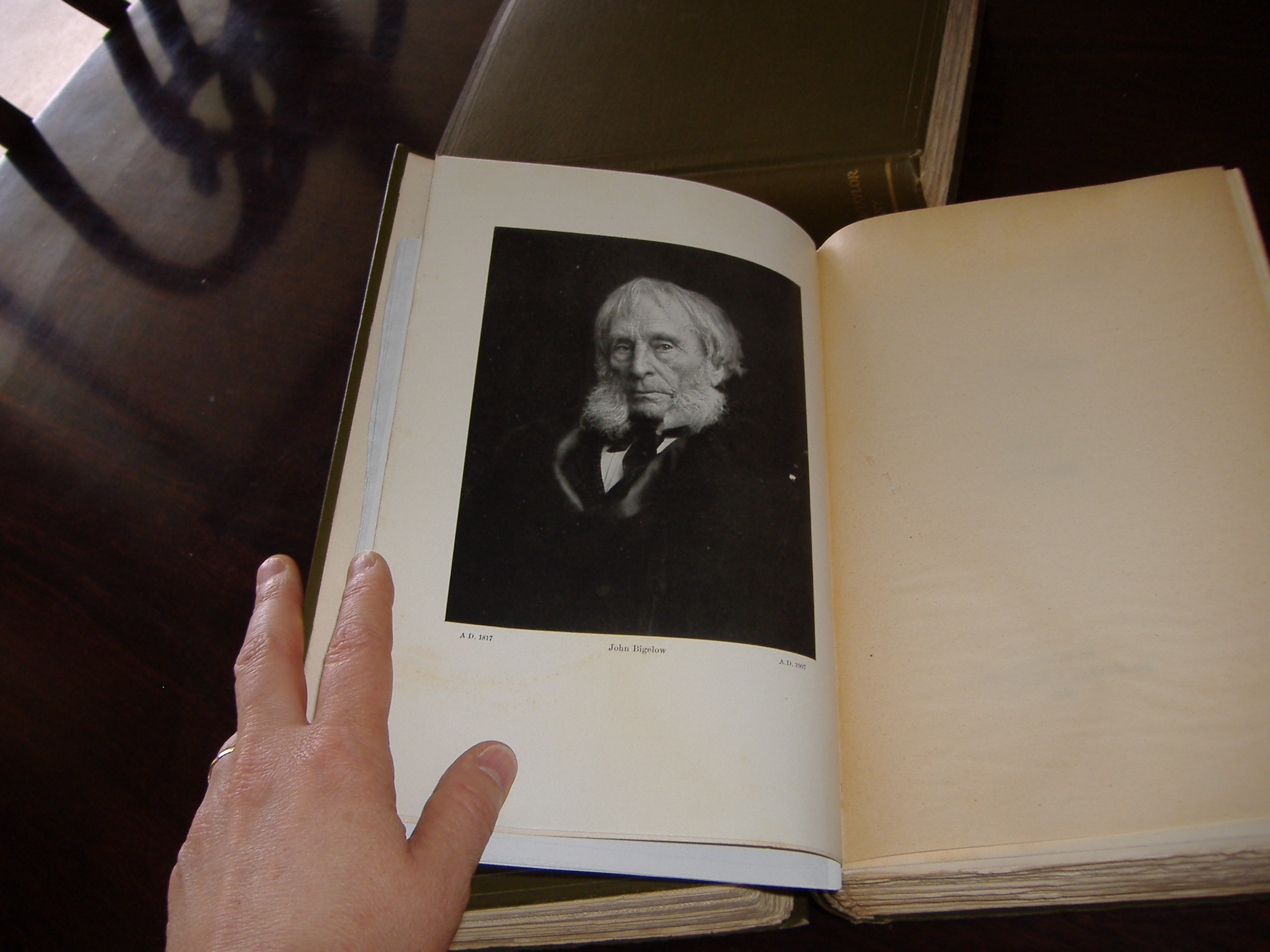 After
a few years of flailing about, the novel suddenly started coming
together with "November 23, 1865: The Charm of Her Existence,"
the chapter now in the middle of the novel when Alicia goes to
Paris, and appeals to John Bigelow, the U.S. ambassador to France,
for help. It's written in John Bigelow's point of view. I was
only able to write this chapter after delving into his papers
at the New York Public Library. After
a few years of flailing about, the novel suddenly started coming
together with "November 23, 1865: The Charm of Her Existence,"
the chapter now in the middle of the novel when Alicia goes to
Paris, and appeals to John Bigelow, the U.S. ambassador to France,
for help. It's written in John Bigelow's point of view. I was
only able to write this chapter after delving into his papers
at the New York Public Library.
It took me a while to realize that there is no single character
that can carry the novel; by necessity, it had to be written
in multiple points of view. The novel has this Roshomon quality,
that is, we go back and see the same story— Alice, frantic
with grief, returning for her child and instead of finding compassion,
she ends up under arrest– from various points of view, each
one a completely different lens, a very different interpretation.
Bigelow's couldn't be more different than Maximilian's, or say,
Frau von Kuhacsevich's or Princess (Pepa) Iturbide's or, for
that matter, a vacationing Prussian count's or the Scottish bookshop
owner's in Paris.
Writing this chapter from Bieglow's point of view was so liberating:
oh, you know, I can do this!
But about the multiple points
of view. Usually when you see multiple points of view it means
that the author has lost control of the narrative, or doesn’t
know what she is doing. The author is asking a lot of the reader
when she uses multiple points of view. But what I realized was
that the main character, the last prince of the Mexican Empire,
is not a person so much as an idea, the living symbol of the
future of the Mexican Empire.
As for hearing voices, yes, that
happens at all points. It's startling sometimes, but also quite
normal when writing fiction. I don't hear voices as if they were
coming out of a radio; rather, a sort of vague nudge, like remembering
a line of dialogue.
So it sounds like you did
start work on the novel before finishing the research.
 Yes,
and in fact, I had a complete draft of the novel when I suddenly
realized that of course, the educated people of that time and
particularly Maximilian would have seen everything through the
lens of classical antiquity. I hadn't emphasized quite as much
as I should have, so I brought in some more Tacitus and Cicero
and Augustus, and so on. And even as the book was in its final
stages, I was able to splice in some bits and pieces (and corrections)
thanks to Dr Konrad Ratz's splendid and very recently published
work on Maximilian, Tras las huellas de un desconocido
(In the footsteps of an unknown), which relies heavily on his
original translations from various German language documents. Yes,
and in fact, I had a complete draft of the novel when I suddenly
realized that of course, the educated people of that time and
particularly Maximilian would have seen everything through the
lens of classical antiquity. I hadn't emphasized quite as much
as I should have, so I brought in some more Tacitus and Cicero
and Augustus, and so on. And even as the book was in its final
stages, I was able to splice in some bits and pieces (and corrections)
thanks to Dr Konrad Ratz's splendid and very recently published
work on Maximilian, Tras las huellas de un desconocido
(In the footsteps of an unknown), which relies heavily on his
original translations from various German language documents.
I should note that Dr Ratz' also
translated and edited a collection of letters between Maximilian
and Carlota. Anyone who reads these letters will see that their
relationship was very different than that painted in most of
the histories. To be sure, their relationship had its challenges,
but Maximilian and Carlota did deeply love and respect one another.
With so many letters over such a long period, this becomes clear.
But what was going on between
them? The novel is full of gossip and rumors, and at one point,
there is the blatant suggestion that Maximilian was homosexual.
And we learn that Maximilian and Carlota do not have a physical
relationship, much to Carlota’s frustration. Or was he asexual?
The answer I prefer is that we
will never know. When you work as a novelist, you try to put
yourself into the place of your characters and imagine what it
must have been like for them. In that spirit, I do think it is
pertinent to note how young they were (he was in his very early
thirties, she was only 25), and how intense the pressure they
were under, constantly, with never a moment of privacy, ever.
They were in great danger; there were assassination attempts.
People around them died of yellow fever, a kind of hemorragic
fever, one of the most ghastly ways to die. And add to that the
fact that Maximilian was plagued with diahrrea, pains in the
liver, fevers, malaria. And as everything began to collapse around
them, they were both suffering unbelievable stress. His health
collapsed and, famously, while visiting the Pope in the Vatican
in 1866, Carlota had a psychotic breakdown from which she never
recovered. Well, but going back to the times in Mexico: this
sort of pressure would have dampened anyone's interest in sex,
no?
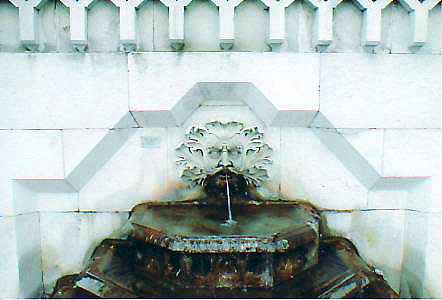
But the fact is that
Maximilian and Carlota had been married for several years before
they came to Mexico, and apparently they thought they never would
have children. In the novel, Alice, the mother of the prince,
has her pet theories– which by the way, are based on an
actual interview she gave to Bigelow when he visited Mexico City
in 1882. For those who haven't yet read the novel, I don't want
to give it away here, but I will say, it's spicey! And she's
a source much closer than most. That said, who knows? There is
endless gossip. People will believe what they want to believe.
The whole novel has this house-of-mirrors quality. That was my
intent.
I know that John Bigelow is
one of your favorite characters, but how about the whole cast?
Do you have personal feelings about them one way or the other
at this point?
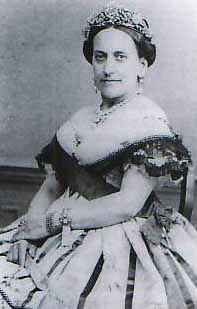 Alice / Alicia was not an easy character;
in my first drafts I was too hard on her. It's easy to condemn
her for giving up her son to Maximilian, but who hasn't been
"a little dazzled maybe," as she put it, about it something,
some time? She had a both adventurous and tenacious spirit and
yet, she was so young and naive. Also, she was under enormous
pressure from a very powerful personality: her older sister-in-law,
who had a great deal to gain from the arrangement with Maximilian.
Maximilian, well, over the years, I feel I made enormous strides
in trying to understand him, but at some level I've lost patience
with him. He was so wrapped up in appearances. You can see that
in his handwriting. And by the way, I did go to books on graphology
to try and understand many of these characters, because my research
was all with handwritten documents. While Alice's handwriting
is forward-slanting, spikey, rhythmic, Maximilian's looks almost
like Arab caligraphy with all these sweeping backward loops.
It's gorgeous, but it must have taken him twice the time it would
take anyone else to write anything! Though his less formal notes
devolve into something rather like Alice's handwriting, now that
I think about it.. Angelo's handwriting was over-large; Carlota's
(before her break down) rigidly neat. Alice / Alicia was not an easy character;
in my first drafts I was too hard on her. It's easy to condemn
her for giving up her son to Maximilian, but who hasn't been
"a little dazzled maybe," as she put it, about it something,
some time? She had a both adventurous and tenacious spirit and
yet, she was so young and naive. Also, she was under enormous
pressure from a very powerful personality: her older sister-in-law,
who had a great deal to gain from the arrangement with Maximilian.
Maximilian, well, over the years, I feel I made enormous strides
in trying to understand him, but at some level I've lost patience
with him. He was so wrapped up in appearances. You can see that
in his handwriting. And by the way, I did go to books on graphology
to try and understand many of these characters, because my research
was all with handwritten documents. While Alice's handwriting
is forward-slanting, spikey, rhythmic, Maximilian's looks almost
like Arab caligraphy with all these sweeping backward loops.
It's gorgeous, but it must have taken him twice the time it would
take anyone else to write anything! Though his less formal notes
devolve into something rather like Alice's handwriting, now that
I think about it.. Angelo's handwriting was over-large; Carlota's
(before her break down) rigidly neat.
I had a lot of fun with the minor
characters. Frau von Kuhacsevich is just the total id, you know?
And Baron d'Huart at once so petulant and sunny, always alert
to beauty and flavor... Lupe the runaway nanny, this sort of
lost lamb. In sum, I feel affection for all of the characters;
there is a little piece of me in all of them. That is part of
the fun of writing a novel. You have to ask yourself, have I
ever felt that way? Maybe you don’t approve of a person
who felt that way, but have you ever, even just a little bit,
felt that way yourself?
When you have been asked why,
after all this research, you decided to write this story as fiction,
you have said that you wanted to tell an emotional truth. Could
you elaborate on that?
Why Maximilian and Carlota came
to Mexico, why Maximilian took the Iturbide child and why the
Iturbides agreed to sign his contract are all questions impossible
to answer without an understanding of their personalities and
motives. Put another way, these are all matters of character
and emotions, and for this kind of exploration the novel, as
a form, is unsurpassed. I think of the form as a kind of vivid
dream or, to use a more modern term, "virtual reality"—
it allows you to experience what it would be like to, say, come
into the parlor and sip ginger tea and pass around a carte-de-visite;
dance at a ball; push through a cheering crowd; smell of the
razorsharp air in a pine forest. And this very vividness is what
invites people, I hope, to feel more empathy with the people
in this time, this place, and caught in these situations.
I’m not saying I want the reader to approve of any of this,
but to come into the experience of it, and so understand it all
a little better.
Put another way, the novelist has more tools to engage the reader.
One of the tools you use to
engage the reader is with the upstairs downstairs interplay.
You say that you researched these people sociologically—the nurses, the bodyguards,
the cooks—but that they are made up. How did this
interplay help you to tell an emotional truth?
Once I realized that this was
a novel about an idea—the last prince not as a person but
as the living symbol of the future of the Empire— and that
therefore it had to be told from multiple points of view, I realized
that I had to have some character or characters, beyond John
Bigelow, who were opposed to Maximilian. And I didn’t want
to go to a higher level, someone like President Benito Juárez
himself, because that would have made the novel unmanageably
big. But I needed a Mexican character who was opposed to the
empire and who was, in some way, going to interact with the other
characters. And it made sense that it might be someone who was
working as a guerilla, who might be a bandit, and the wonderful
thing of making him a bandit is that I could have him take on
the nanny, who runs off when the Iturbides leave Mexico City.

Another wonderful thing about choosing a bandit is that I could
take the action to Rio Frio, a place on the highway in the mountains
between Mexico City and Puebla where bandits often attacked the
stagecoaches.
A true and absolutely devastating embarrassment for Maximilian—
mentioned in all the histories of the empire—was the murder
of Baron Frédéric Victor d'Huart, the Belgian envoy
and close friend of Carlota's brother of the Duke of Flanders,
at Rio Frio. This story is told in the chapter "March 4,
1866: Río Frío" and (in Maximilian's flashbacks)
"July 10, 1866: One Stays the Course".
Why do you think we in the
United States are generally so ignorant about our immediate neighbor
to the South?
There are constellations of reasons,
and everyone, including our most celebrated PhDs in Mexican Whatever,
is to some degree ignorant, for no one can know everything! But
I prefer to flip the question and ask, why are people in other
countries so ignorant about the United States? Is it arrogance?
Laziness? Cowardice? Other prioirities? Cognitive dissonance?
This is a many-faceted question and for each individual at each
moment in time, the answer can change.
So, coming back to Mexico, The
Last Prince of the Mexican Empire is a story to open
your mind, however closed, however open it may already be. Come
in and hear all about it!
What are some of the things you want the reader who accepts your
invitation "to come on in and hear all about it" to
discover?
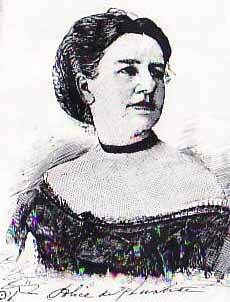 First, that the prince's mother was not
only an American, but an American from very prominent family
in Washington society—the aristocracy of her time and place.
She was the granddaughter of the Revolutionary War General Uriah
Forrest and she was also descended from Maryland's Governor Plater,
major figures in their time. So it shouldn't be a surprise that
she had the wherewithal to get up what was truly an international
scandal over Maximilian's refusal to return her child. First, that the prince's mother was not
only an American, but an American from very prominent family
in Washington society—the aristocracy of her time and place.
She was the granddaughter of the Revolutionary War General Uriah
Forrest and she was also descended from Maryland's Governor Plater,
major figures in their time. So it shouldn't be a surprise that
she had the wherewithal to get up what was truly an international
scandal over Maximilian's refusal to return her child.
And though his novel takes place mostly in Mexico and in Europe,
this is very much an American story. It was only with the U.S.
embroiled din its own Civil War that France dared to invade Mexico.
And later, after the Confederates surrender, without the support
of the United States, it would have been a far tougher battle
for the Juaristas to retake Mexico.
Second, this is a story of foreign
intervention. I was working on this novel when our government
invaded Iraq, and most of the people opposed to this brought
up the specter of Vietnam. But it seems to me that a more apt
comparison would have been to the French in Mexico which, alas,
most Americans know little if anything about.
Finally, this is a novel about
compassion and forgiveness.
If there is any one thing that you want the reader to take away
from this novel, what would that be?
That there are infinite layers
of complexity. And that every time we hold a candle to the past,
we also illuminate the present.
Questions
for Discussion
What was your immediate
response to this novel? Have you ever visited Mexico? How much
about Mexico did you know, or think you knew, before reading
this novel? How and in what ways did this novel add to or change
your impressions and knowledge of Mexican history and culture?
How would you describe
the tone and style of this novel? What did you enjoy most about
the novel?
Do you agree with the
author’s decision to tell this story as fiction? Discuss
the pros and cons of her reasons for doing so, including her
contention that novelists are, or should be, "armchair sociologists."
What do you think she means by that? What do you think she means
by wanting to tell "an emotional truth?"
The author says that
the main character of the novel is an Idea – the Idea being
the future of Empire in Mexico, so she had to tell it from multiple
points of view, which she thinks is asking a lot of the reader.
Did you find that to be so? How satisfied were you with her structure
of organizing Book Two of the novel around dates delineating
the life of the contract between the Iturbides and Maximilian?
Do you think she succeeded in making the multiple points of view
easier for readers to follow by using that structure?
Discuss the way the
author uses gossip and rumor (all of which is historically accurate,
from her meticulous research) to tell her story. What do you
think she wants the reader to conclude from its use?
Who are your favorite
characters in the novel? Why? Which ones are the most interesting
to you, and why? How and why, or why not, did you identify with
any of them? Why do you suppose the author would say that there
were things about Alicia that she could relate to?
What were your initial
impressions, or opinions about, Maximilian and Carlota? If they
changed or evolved as the novel progressed, identify and discuss
one or more scenes from the novel that changed your point of
view about them. Do the same exercise for Alicia and Angelo Iturbide,
and Pepa.
Why do you think the
Iturbides entered into the contract with Maximilian to grant
him custody of their son, Augustin? Discuss from the points of
view of all members of the family. Why do you think Maximilian
and Carlota wanted to take custody of him?
When the author describes
this novel as "an American story," what does that mean
to you? Do you agree with her? Why, or why not, as the case may
be?
If you could talk with
the author, what are some questions that are unanswered in Book
Three and the Epilogue you would want to ask her about?
This novel is remarkable
in its attention to the accurate, historical detail of daily
life—how people dressed, what they ate, where
they lived, how they entertained, how the table was set for a
state dinner, the protocol for lunch, the social structure in
a bandit’s lair, and more, much like the HBO mini-series,
John Adams. If you were producing a movie or mini-series version
of this novel, who would you cast in the major roles?
Recommended
Reading
"From
Mexico to Miramar or, Across the Road to Oblivion,"
by C. M. Mayo (see above for source)
The War of the End
of the World,
by Mario Vargas Llosa
Woe to Live On, by Daniel Woodrell (alternate
title: Ride with the Devil).
A Flag for Sunrise, by Robert Stone
Nostromo, by Joseph Conrad
The Bandits of Rio
Frio, by Manuel
Payno, translated by Alan Fluckey
Hallem’s War, by Elizabeth Payne Rosen
The Hummingbird’s
Daughter, by
Luis Alberto Urrea
The Leopard, by Guiseppe di Lampedusa
Open Veins of Latin
America, by
Eduardo Galeano, with a forward by Isabel Allende
John Adams, a seven part HBO mini-series,
available on DVD, based upon David McCollough’s Pulitzer
Prize winning book of the same name.
>More
information for book groups.***
"Mayo's reanimation
of a crucial period in Mexican history should satisfy history
buffs and those in the mood for an engaging story brimming with
majestic ambition.
Publisher's
Weekly
"a swashbuckling, riotous good time, befitting the fairy-tale
promise of the opening sentence"
Austin
American-Statesman
"Mayo’s cultural insights are first-rate, and the glittering,
doomed regime comes to life"
Library
Journal (Xpress Review)
"I have read a few sweeping historical novels that have
remain inside of me forever. Tolstoy's War and Peace is
one of those, Dickens's A Tale of Two Cities is another,
Pasternak's Doctor Zhivago is another, and now The
Last Prince of the Mexican Empire is another."
Mexico
Connect |
Tulpa
Max or, Notes on the Afterlife of a Resurrection
Catamaran Literary Reader, summer 2017. Also published in Spanish
in Letras Libres.
On Seeing as an Artist or, Five Techniques for a Journey to Einfühlung
Transcript of my remarks for the panel on "Writing Across
Borders and Cultures" Women Writing the West Conference,
Santa Fe, New Mexico, October 15, 2016
C.M.
Mayo at the Library of Congress
 A
presentation of the the novel, The
Last Prince of the Mexican Empire, and an overview of
the author's research in the various archives in the Library
of Congress, among them, the papers of the Iturbide family, the
Emperor Iturbide, and the circa 1920 copies of a substantial
portion of the Kaiser Maximilian von Mexiko archive in Vienna.
The lecture was sponsored by the Hispanic Division of the Library
of Congress, which is the center for the study of the cultures
and societies of Latin America, the Caribbean, the Iberian Peninsula
and the Spanish Borderlands, and other areas with Spanish and
Portuguese influence. Recorded live July 20, 2009. A
presentation of the the novel, The
Last Prince of the Mexican Empire, and an overview of
the author's research in the various archives in the Library
of Congress, among them, the papers of the Iturbide family, the
Emperor Iturbide, and the circa 1920 copies of a substantial
portion of the Kaiser Maximilian von Mexiko archive in Vienna.
The lecture was sponsored by the Hispanic Division of the Library
of Congress, which is the center for the study of the cultures
and societies of Latin America, the Caribbean, the Iberian Peninsula
and the Spanish Borderlands, and other areas with Spanish and
Portuguese influence. Recorded live July 20, 2009.

(APPROX
1 HOUR)
The Book Studio
Bethanne Patrick
("The Book Maven") interviews C.M. Mayo about The
Last Prince of the Mexican Empire and
the Washington DC story behind the story. January 22, 2010.

Connections
Literary Magazine: "The Politics of Love"
Mary J. Lohnes interviews
C.M. Mayo about The Last Prince of the Mexican Empire. October
2010.
Jenn's
Bookshelves Blog
Interview by Jenn about The Last Prince of the Mexican Empire.
November 12, 2010.
Historicalnovels.info
An
interview by historical novels blogger Margaret Donsbach. October
20, 2010.

Latina
Book Club
Maria
Ferrer's NYC-based blog, embracing Hispanic heritage. September
15, 2010.
 El Calendario de Todos Santos El Calendario de Todos Santos
Writer Michael Mercer
interviews C.M. Mayo about the writing of The Lasst Prince
of the Mexican Empire. March 2010
Coffee
with a Canine Blog
Interview by Marshal
Zeringue. November 25, 2009.
Critical
Mass: National Book Critics Circle
Small Press Spotlight:
An Interview with C.M. Mayo by Rigoberto Gonzalez. October 11,
2009.

Fall for the Book Festival (George Mason University): David
Heath interviews C.M. Mayo about The Last Prince of the Mexican
Empire and the story behind the story of Mexico's half-American
prince. September 2009. (To read the complete interview, which
includes previously unpublished Q & A about the Empress Carlota,
click
here.)
Amigos
de la Universidad de Chicago
(University of Chicago Mexico Alumni Association)
Apropos of the presentation
of The Last Prince of the Mexican Empire in Mexico City
September 2009.
 Click
here for photos of the event. Click
here for photos of the event.
Write
On! Online
Debra Eckerling
interviews C.M. Mayo about The Last Prince of the Mexican
Empire and the writing process. July 3, 2009.
 Largehearted
Boy Largehearted
Boy
A guest-blog post with a playlist for The Last Prince of the
Mexican Empire.
Savvy Verse & Wit Interview by leading book blogger Serena
Agusto-Cox about The Last Prince of the Mexican Empire.
Whereabouts
Press Blog
John
Bennett interviews C.M. Mayo about The Last Prince of the
Mexican Empire— and some of the stories
(by Araceli Ardón, Fernando del Paso,
Mónica Lavín) in Mexico: A Traveler's
Literary Companion.
Ten
Questions for C.M. Mayo
Writerly interview
by Wendy Burt March 1, 2009.
 More interviews More interviews
Many of the more recent interviews about later books also discuss
The Last Prince of the Mexican Empire and Mexican history.
A few guest-blogs and comments:
What Connects
You to the 1860s?
The
Top 5 of the Tussie-Mussie
About
the Jamesian Roving Intelligence
 More
on the research behind this book More
on the research behind this book
 Contact
C.M. Mayo Contact
C.M. Mayo
|



 The Last Prince of the Mexican Empire
The Last Prince of the Mexican Empire on
a life of its own, and the story of two heartbroken parents trying
to get their little boy back from a callous pair of Royals growing
more unstable by the day as the French withdraw from Mexico and
their Second Empire comes crashing down around them, grew into
something much larger: an international story of political intrigue,
war and diplomacy that plays out in Mexico City,
on
a life of its own, and the story of two heartbroken parents trying
to get their little boy back from a callous pair of Royals growing
more unstable by the day as the French withdraw from Mexico and
their Second Empire comes crashing down around them, grew into
something much larger: an international story of political intrigue,
war and diplomacy that plays out in Mexico City, 



 Yes,
in most cases they corresponded, but the structure of the novel
is that the opening three chapters, Book One, are set in a certain
time period but not on a particular day. The same can be said
of Book Three.
Yes,
in most cases they corresponded, but the structure of the novel
is that the opening three chapters, Book One, are set in a certain
time period but not on a particular day. The same can be said
of Book Three.  The
Second Empire was the assertion by the French, the Catholic Church,
and a group of Mexican conservatives that Mexicans should be
subjects. On the other hand, the Juarista response— ultimately
victorious— was that, no, Mexicans are citizens. Citizens
of a Republic. There is a fundamental difference between being
a subject and being a citizen. The former requires obedience
while the latter calls for participation. I could go on. But
more than that: Maximilian, for instance, genuinely saw himself
as Mexican, whereas any modern Mexican would probably roll their
eyes and huff, "how ridiculous!" Maximilian was an
Austrian aristocrat, imposed by a foreign army. Yet let's not
forget, in fact there were many Mexicans who welcomed and supported
him.
The
Second Empire was the assertion by the French, the Catholic Church,
and a group of Mexican conservatives that Mexicans should be
subjects. On the other hand, the Juarista response— ultimately
victorious— was that, no, Mexicans are citizens. Citizens
of a Republic. There is a fundamental difference between being
a subject and being a citizen. The former requires obedience
while the latter calls for participation. I could go on. But
more than that: Maximilian, for instance, genuinely saw himself
as Mexican, whereas any modern Mexican would probably roll their
eyes and huff, "how ridiculous!" Maximilian was an
Austrian aristocrat, imposed by a foreign army. Yet let's not
forget, in fact there were many Mexicans who welcomed and supported
him.  This
is the story of the defeat of an idea: the monarchy. Today Mexicans
are not subjects but citizens. Let's not forget, one hundred
fifty years ago, the monarchical form of government, while not
universally, was widely accepted. This period in history is also
significant because, though Mexico has had a long history of
foreign invasions, and this was the ugliest of all. It was massive
and brutal, and though strenuous efforts, it was defeated. This
is why Cinco de Mayo, the commeoration of the battle of Puebla
on May 5, 1862, is so important to Mexicans. It was not a definitive
defeat of the French— only a temporary one, it turned out,
for the French regrouped and took Puebla a year later. However,
it was powerfully symbolic. That the rag-tag Army of the Republic
of Mexico could humiliate the French Imperial Forces, then considered
the greatest in the world, was no small thing. It was David slingshotting
Goliath: an international sensation.
This
is the story of the defeat of an idea: the monarchy. Today Mexicans
are not subjects but citizens. Let's not forget, one hundred
fifty years ago, the monarchical form of government, while not
universally, was widely accepted. This period in history is also
significant because, though Mexico has had a long history of
foreign invasions, and this was the ugliest of all. It was massive
and brutal, and though strenuous efforts, it was defeated. This
is why Cinco de Mayo, the commeoration of the battle of Puebla
on May 5, 1862, is so important to Mexicans. It was not a definitive
defeat of the French— only a temporary one, it turned out,
for the French regrouped and took Puebla a year later. However,
it was powerfully symbolic. That the rag-tag Army of the Republic
of Mexico could humiliate the French Imperial Forces, then considered
the greatest in the world, was no small thing. It was David slingshotting
Goliath: an international sensation. It
would be difficult to overstate the power of the Church in Mexico
at that time. Just in Mexico City, when you see how much real
estate they owned, nd how much money the Church had, it is really
jaw-dropping. And they also owned huge haciendas worked with
slaves. So that was a continuing is
It
would be difficult to overstate the power of the Church in Mexico
at that time. Just in Mexico City, when you see how much real
estate they owned, nd how much money the Church had, it is really
jaw-dropping. And they also owned huge haciendas worked with
slaves. So that was a continuing is sue
throughout the 19th century in Mexico – how much power does
the church have, and how much the state? The Church supported
Maximilian and the French invasion in part because the Republicans
had confiscated Church property. It turned out, however, that
Maximilian did not reinstate the Church's properties. It just
wasn't feasible. But this remained a source of friction between
Maximilian and the Church. Another was that Maximilian was a
little too liberal for the Church; among other things the Church
objected to, he wanted to encourage immigration from ther ex-Confederacy
and from Europe, and he was willing to accept (gasp!) freedom
of worship for Protestants. In sum, though the Church supported
the Mexican Empire, it had its own interests and they did not
invariably align with Maximilian's.
sue
throughout the 19th century in Mexico – how much power does
the church have, and how much the state? The Church supported
Maximilian and the French invasion in part because the Republicans
had confiscated Church property. It turned out, however, that
Maximilian did not reinstate the Church's properties. It just
wasn't feasible. But this remained a source of friction between
Maximilian and the Church. Another was that Maximilian was a
little too liberal for the Church; among other things the Church
objected to, he wanted to encourage immigration from ther ex-Confederacy
and from Europe, and he was willing to accept (gasp!) freedom
of worship for Protestants. In sum, though the Church supported
the Mexican Empire, it had its own interests and they did not
invariably align with Maximilian's. On
its face, this is a confusing story. Why did Maximilian take
the little boy away from his parents and exile them? And why
did the parents, at least initially, agree to this? To answer
these questions we have to first, understand the social and political
context at the time, and second, get beyond our common understanding
of the meaning of a family. Many historians talk about Maximilian's
"adopting" the little boy, but that is not quite the
right word.
On
its face, this is a confusing story. Why did Maximilian take
the little boy away from his parents and exile them? And why
did the parents, at least initially, agree to this? To answer
these questions we have to first, understand the social and political
context at the time, and second, get beyond our common understanding
of the meaning of a family. Many historians talk about Maximilian's
"adopting" the little boy, but that is not quite the
right word.  The
second reason why it was difficult to tell the story is that
the period itself is incredibly complex. In fact we cannot consider
it "Mexican" history so much as it is transnational
history. Why did French invade Mexico? Why did the Church support
this? Why did the Kaiser of Austria allow his younger brother
go? Who was Maximilian's wife, the Empress Carlota? She was the
Princess of Belgium and the first cousin of Queen Victoria. And
both King Leopold of the Belgians and Queen Victoria had plenty
to say about Mexico. England had many important businesses in
mining and textiles and so on, so the British Ambassador was
an important figure in Mexico, and in any event, what Queen Victoria
thought of all this was vital to all concerned. And of course
the United States were scheming to get the French out of Mexico,
plus there was the business of the Confederacy and its relationship
to Mexico. So it was an extraordinarily complex period.
The
second reason why it was difficult to tell the story is that
the period itself is incredibly complex. In fact we cannot consider
it "Mexican" history so much as it is transnational
history. Why did French invade Mexico? Why did the Church support
this? Why did the Kaiser of Austria allow his younger brother
go? Who was Maximilian's wife, the Empress Carlota? She was the
Princess of Belgium and the first cousin of Queen Victoria. And
both King Leopold of the Belgians and Queen Victoria had plenty
to say about Mexico. England had many important businesses in
mining and textiles and so on, so the British Ambassador was
an important figure in Mexico, and in any event, what Queen Victoria
thought of all this was vital to all concerned. And of course
the United States were scheming to get the French out of Mexico,
plus there was the business of the Confederacy and its relationship
to Mexico. So it was an extraordinarily complex period. After
a few years of flailing about, the novel suddenly started coming
together with "November 23, 1865: The Charm of Her Existence,"
the chapter now in the middle of the novel when Alicia goes to
Paris, and appeals to John Bigelow, the U.S. ambassador to France,
for help. It's written in John Bigelow's point of view. I was
only able to write this chapter after delving into his papers
at the New York Public Library.
After
a few years of flailing about, the novel suddenly started coming
together with "November 23, 1865: The Charm of Her Existence,"
the chapter now in the middle of the novel when Alicia goes to
Paris, and appeals to John Bigelow, the U.S. ambassador to France,
for help. It's written in John Bigelow's point of view. I was
only able to write this chapter after delving into his papers
at the New York Public Library.  Yes,
and in fact, I had a complete draft of the novel when I suddenly
realized that of course, the educated people of that time and
particularly Maximilian would have seen everything through the
lens of classical antiquity. I hadn't emphasized quite as much
as I should have, so I brought in some more Tacitus and Cicero
and Augustus, and so on. And even as the book was in its final
stages, I was able to splice in some bits and pieces (and corrections)
thanks to Dr Konrad Ratz's splendid and very recently published
work on Maximilian, Tras las huellas de un desconocido
(In the footsteps of an unknown), which relies heavily on his
original translations from various German language documents.
Yes,
and in fact, I had a complete draft of the novel when I suddenly
realized that of course, the educated people of that time and
particularly Maximilian would have seen everything through the
lens of classical antiquity. I hadn't emphasized quite as much
as I should have, so I brought in some more Tacitus and Cicero
and Augustus, and so on. And even as the book was in its final
stages, I was able to splice in some bits and pieces (and corrections)
thanks to Dr Konrad Ratz's splendid and very recently published
work on Maximilian, Tras las huellas de un desconocido
(In the footsteps of an unknown), which relies heavily on his
original translations from various German language documents.
 Alice / Alicia was not an easy character;
in my first drafts I was too hard on her. It's easy to condemn
her for giving up her son to Maximilian, but who hasn't been
"a little dazzled maybe," as she put it, about it something,
some time? She had a both adventurous and tenacious spirit and
yet, she was so young and naive. Also, she was under enormous
pressure from a very powerful personality: her older sister-in-law,
who had a great deal to gain from the arrangement with Maximilian.
Maximilian, well, over the years, I feel I made enormous strides
in trying to understand him, but at some level I've lost patience
with him. He was so wrapped up in appearances. You can see that
in his handwriting. And by the way, I did go to books on graphology
to try and understand many of these characters, because my research
was all with handwritten documents. While Alice's handwriting
is forward-slanting, spikey, rhythmic, Maximilian's looks almost
like Arab caligraphy with all these sweeping backward loops.
It's gorgeous, but it must have taken him twice the time it would
take anyone else to write anything! Though his less formal notes
devolve into something rather like Alice's handwriting, now that
I think about it.. Angelo's handwriting was over-large; Carlota's
(before her break down) rigidly neat.
Alice / Alicia was not an easy character;
in my first drafts I was too hard on her. It's easy to condemn
her for giving up her son to Maximilian, but who hasn't been
"a little dazzled maybe," as she put it, about it something,
some time? She had a both adventurous and tenacious spirit and
yet, she was so young and naive. Also, she was under enormous
pressure from a very powerful personality: her older sister-in-law,
who had a great deal to gain from the arrangement with Maximilian.
Maximilian, well, over the years, I feel I made enormous strides
in trying to understand him, but at some level I've lost patience
with him. He was so wrapped up in appearances. You can see that
in his handwriting. And by the way, I did go to books on graphology
to try and understand many of these characters, because my research
was all with handwritten documents. While Alice's handwriting
is forward-slanting, spikey, rhythmic, Maximilian's looks almost
like Arab caligraphy with all these sweeping backward loops.
It's gorgeous, but it must have taken him twice the time it would
take anyone else to write anything! Though his less formal notes
devolve into something rather like Alice's handwriting, now that
I think about it.. Angelo's handwriting was over-large; Carlota's
(before her break down) rigidly neat.

 El Calendario de Todos Santos
El Calendario de Todos Santos
 Largehearted
Boy
Largehearted
Boy